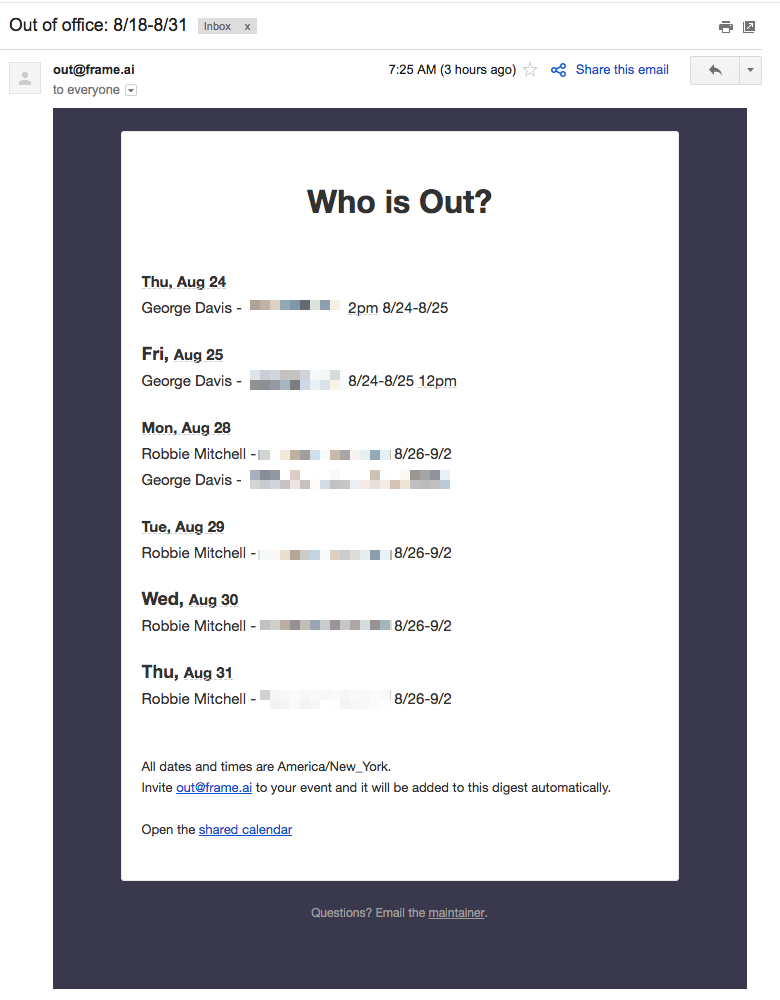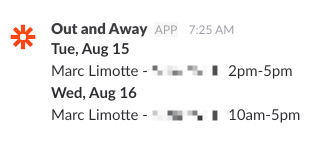Picture this: you're blocking off some time for a vacation. Just invite this special user (e.g., out@yourdomain.com) to your out-of-office calendar event and it will be automatically rolled into a shared calendar, email digest, and chat notification for your coworkers to see.
No more pestering your coworkers repeatedly about an upcoming vacation or forgetting to tell people about a doctor appointment because you quietly "added it to your calendar" and forgot about it.
This Google Apps Script can:
- Create a shared calendar of who and when everyone you care about will be out of office
- Periodically emails your chosen team a digest aggregating upcoming out-of-office time
- Periodically send a webhook event with today and tomorrow's out-of-office time -- handy for routing to Slack or Zapier
- Do this for as many distinct groups as you want. Use one group ("everyone@company.com") for a small company, or break things out into teams and functional groups.
- Matches users who are indirect/nested group members of the parent group (e.g., "group" -> "subgroup" -> "user")
For every group you want to aggregate, the variables can be configured on a single row in the Sheet. How often to email and webhook, how much upcoming time it should cover, who should be notified, etc.
Just invite the new out@<yourdomain.com> user to your vacation/offsite/sick day/etc. and it will show up on the shared calendar and in the digest.
Sample email digest:
Sample Slack notification (via webhook):
- Add your group as a new row in the Groups tab of the shared Who Is Out sheet.
- Wait until the next scheduled
updateGroupstrigger (i.e., overnight).- If you have script access, you can run
updateGroupsthenupdateCalendarsmanually to activate your group right away.
- If you have script access, you can run
- (optional) For each new sheet row, the script will automatically share a calendar with the recipients so they can see all the events any time. This shared calendar preserves the original event titles.
- Go to the developer console and enable the following APIs: Admin SDK, Google Calendar API
- Log in to the admin console and create a new user, such as
out@<yourdomain> - Give the user elevated privileges. Create a new role (e.g.,
Calendar Reader) and give it Read access tousers,organization units, andgroups. Apply this role to the newout@user.
-
Copy this Sheet and save to
My Drive -
Share it with yourself (your real email address) with full write access so you can access it easily in the future.
- Note: if you edit the sheet at your personal account, be careful not to edit or run the scripts unless you're using the special out@ user.
-
Recommended: Protect the
Instructions,Setup, andFlattened Groupstabs so others don't mistakenly overwrite them -
Add your own real email address to
A2in theSetuptab -- this will list you as the maintainer -
For each group that wants to use this, fill out the rows in the
Groupstab. You can do it yourself or share with others.- Recommended: For testing purposes, set the
Email RecipientsandShare Calendar Withvalues in theGroupstab (columns D and E) to your own email address until you are ready to set it loose and change to the real values. - Note: the group membership must be visible to the
out@<yourdomain>user. If you run into a situation where the group restricts membership visibility, you'll need to contact an admin of that group and ask them to change it.
- Recommended: For testing purposes, set the
-
Open Tools -> Script editor...
-
In your script project, open Resources -> Cloud Platform Project...
-
An overlay will say "This script is currently associated with project:" ... click the link. If there is no link, give the project a name first, then click the resulting link.
-
Search for and enable the following API: Admin SDK
Close out of this to return to your script project.
- Open Resources -> Advanced Google services...
- Enable
Admin Directory APIandCalendar API - Click OK
Now we can create the scripts.
- Create this empty script (File -> New -> Script file):
trigger.gs. Copy/paste the contents from that file in this repo to your new script, completely overwriting the defaultmyFunctioncode in your new script. Repeat this for the rest of the.gsscript files.
- Run
updateGroups(Run -> updateGroups). This will aggregate all the subgroups contained by the desired (parent) groups, which will then be used to match users with the parent group even if they are indirect members (members of subgroups). If you are prompted for permission to execute the script, you should approve. - Run
updateCalendars. This will update and share all shared calendars. It will also create them if they don't yet exist. Approve any requested permissions. - Run
notify. This will send the email digest(s) and trigger the webhook(s) if applicable. Approve any requested permissions.
Once you feel like everything is working, you can set it loose.
- Create an hourly trigger for
updateCalendars - Create a daily trigger for
notify. This is commonly set to first thing on a weekday, such as between 7-8am. Even if you trigger it every day, default values in theSetuptab and group-specific overrides in theGroupstab will actually control whether the emails and webhooks are sent. - Create a daily trigger for
updateGroups. It makes sense to set this for after close of business but before the dailyupdateAndNotifyjob runs, such as 3-4am.
- Fork it!
- Create your feature branch:
git checkout -b my-new-feature - Commit your changes:
git commit -am 'Add some feature' - Push to the branch:
git push origin my-new-feature - Submit a pull request :)
Inspired by a daily digest we had at Cover in NYC (RIP). Upgraded through experience at frame.ai and discussions with other startup employees who use it.
The inspiration for this project was two old scripts cobbled together:
- events.gs is based on Google Apps Script Vacation Calendar by Stephanie Obodda
- digest.gs is based on Daily Digest by Amit Agarwal

